When the Taliban retook control of Afghanistan in August 2021, 20 years after their expulsion by U.S. troops, the American War ended. During those two decades of war, 200,000 Afghans tragically lost their lives. But now, a potentially more dangerous war is brewing. This nameless war has no clear enemy. Instead, it is a battle of survival for the Afghan people.
Throughout the spring and summer of 2021, a third wave of COVID spread across the country like wildfire. With limited ways to protect themselves, a lack of understanding about the virus, and virtually no access to the vaccine to prevent it, countless Afghans succumbed to illness and death. When the Taliban seized power in August, the battle for survival intensified.
Government services and international aid have all but ceased leaving Afghanistan’s economy on the verge of collapse. Only 5% of households report they have enough food to eat, and with winter fast approaching, the outlook is grim. Most at risk are more than 400,000 women and children who have been displaced since the beginning of 2021. Penniless, homeless, and with no way to support themselves, they are on the frontlines of this new, nameless war.
Of the approximate 550,000 Afghans displaced in 2021, about 80% are women and children.
Thanks to your generous support, to date, Central Asia Institute has helped thousands of the most vulnerable Afghans. To combat the spread of COVID, you’ve helped provide:
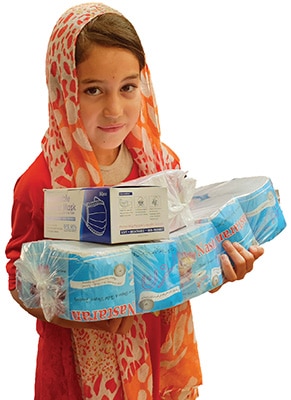
In addition, women-led families and female students in Takhar and Kapisa provinces benefited from 13,700 handwashing stations and 12,160 facemask kits. And loudspeaker messages about COVID-19 were broadcast in camps for displaced people to decrease infection rates and encourage social distancing and proper hygiene.
Around 18 million Afghans, almost half the population, are now in urgent need of humanitarian assistance, according to the International Federation of Red Cross and Red Crescent Societies. Unfortunately, the need will likely increase.
At Central Asia Institute, we’re doing everything in our power to assist communities affected by the crisis. In the coming weeks, we’re planning to distribute an additional 300 bedding kits (blankets, tarps for shelter, etc.), 300 hygiene kits (soap, menstrual hygiene products, etc.), and 300 education kits (books, pencils, etc.) to displaced families.
Nearly 18 million Afghans, almost half the population, are in urgent need of humanitarian assistance.

The crisis in Afghanistan cannot be explained through statistics alone. Hearing from people like Aisha, whose heartfelt letter opened the Journey of Hope magazine, is the best way to understand the situation. So we thought it was only right for her words to close the magazine as well.
Hello and salam (peace) to the world. My name is Aisha, and I’m 21 years old. I am one of the displaced people who fled from Kapisa to Kabul. By the time I am writing this, the Taliban have captured Afghanistan—my country! Now girls are being forced into marriage, female workers marched away from their jobs, and activists' homes raided in a clear message that the freedoms of the last 20 years are coming to an end. I'm worried about my future. I won't be allowed to get an education, work, go outside, or live the life I want. I feel like I am in prison without having committed a crime. For this new generation of Afghan girls, who grew up going to school and nurturing unfettered dreams, the Taliban era is ancient history, and turning back the clock is a nearly incomprehensible fate. Please, do not leave us alone. We have not forgotten the help that other countries offered us in the past, and we will not forget any help you offer us now. Please release us from this prison. Please help my people. Please help Afghanistan!
- Aisha
The situation in Afghanistan is changing rapidly. Please visit centralasiainstitute.org for the most up-to-date information about what’s happening on the ground and our efforts to support the Afghan people.
By Alice Thomas
Across the globe, people are feeling the effects of climate change—from hurricanes to flooding to droughts to wildfires. Tragically, the poorest, most marginalized people are often the hardest hit.
In the regions of Central Asia where CAI works, extreme weather is a part of life. But as the climate changes, poor and vulnerable communities are finding it harder to cope. Adding to the problem is that governments in this region have limited capacity to prepare for and respond
to disasters.
For example, Afghanistan is currently facing a severe drought that comes on the heels of the 2018-2019 drought. As of early September 2021, some 7 million Afghans who depend on agriculture and raising livestock to survive required humanitarian assistance.i With lower-than-usual harvests expected this fall, Afghan farmers are bracing for the worst this winter. Even before the government fell to the Taliban, former President Ashraf Ghani acknowledged that the government lacked the funds and capacity to manage the impending crisis.
While climate change is impacting all regions in the world, ecologically fragile, high-mountain areas face unique risks. Nowhere is this more evident than the remote and mountainous areas of Afghanistan, Pakistan, and Tajikistan, where CAI has long focused. The Pamir, Karakoram, and Himalayan ranges are part of the broader Hindu Kush Himalayan (HKH) region, which is known as the “Roof of the World” because it has some of the tallest peaks on Earth. Many are covered with deep glaciers and serve as water towers on which billions of people living in the broader Asia region depend for fresh water and food.
But in recent years, warmer temperatures have accelerated glacial melting, resulting in more intense flooding and, over the long term, depletion of water sources. The United Nations recently warned that even conservative scenarios for future global warming indicate that the region will lose one-third of its ice volume by the year 2100.ii
“I have noticed that the number of glaciers is decreasing, and the glaciers are melting and causing natural disasters like mudslides,” explained one senior geologist from Tajikistan who helps communities prepare for the effects of climate change. “The water level of the rivers is getting higher, washing out the roads and the crop fields.”
Farmers in the region are noticing the changes as well. Gulru and her family have been farming their plot of land for more than 60 years. “The climate has changed a lot,” she said. “Before we had very good harvest from our little field, but this year our field was destroyed by a mudslide. Then, after we cleaned the field and planted vegetables, the harvest was not good. There wasn’t enough rain and all the crops dried up. So, this year we have to buy our vegetables from the market.”
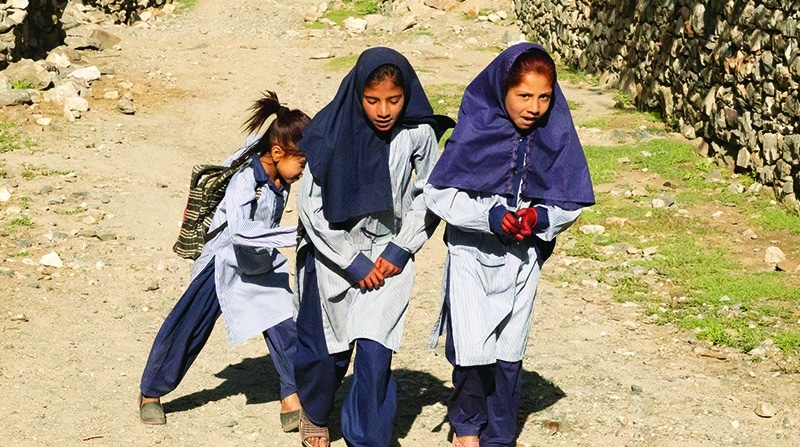
In the HKH region and other poor and ecologically fragile parts of the globe, women and girls bear the brunt of extreme weather and climate change. Poverty and other economic, social, and cultural factors act to heighten their vulnerability to climate change impacts. At the same time, they have far less access than men to the resources, knowledge, and decision-making that would help them to recover and adapt.
For example, when disasters like flash flooding or typhoons occur, women and girls are far more likely to be killed or displaced. Females living in displacement camps also face a heightened risk of sexual exploitation and abuse.
In the case of long-term disasters like droughts, socio-cultural norms and childcare responsibilities can prevent women from migrating to urban areas to seek
assistance or find jobs. When food is scarce, mothers often forgo meals so that the males and small children can eat. They must also travel greater distances to get water, increasing the risk of
gender-based violence.
Climate-related disasters have also been shown to contribute to a rise in early childhood marriages by exacerbating poverty and incentivizing families to marry off young daughters. Girls are also more likely than boys to drop out of school when their families are facing environmental crises.
The same social, economic, and cultural factors that make women and girls more vulnerable to extreme weather often prevent them from participating in solutions.iii Because women in the remote communities CAI serves are often illiterate and lack resources, they are less equipped to adapt to climate change. And because they aren’t included in decision-making and planning processes, they are unable to participate in devising climate solutions.
The good news is that research shows that educating women and girls may be one of the best ways to overcome these problems. Education not only opens the door to more opportunities, it also allows women to be better stewards of the environment while building their resilience to extreme weather and the impacts of climate change.
In addition, education plays an important role in promoting female reproductive health and rights. Studies show that women who are educated have healthier births and greater control over their bodies. They can better decide when to have children and how many to have. According to Project Drawdown, a nonprofit organization that works on climate solutions and research, “Estimates suggest that together with family planning, girls’ education has the potential of avoiding nearly 85 gigatons of carbon emissions by 2050.”iv That’s a big reduction considering that in 2020, global carbon emissions from fossil fuels were 9.3 gigatons.v In fact, Project Drawdown includes girls’ education as one of the top 10 strategies for combating global warming.
Another factor supporting girls’ education as an effective strategy for addressing climate change is that women have been shown to make excellent environmental leaders. Studies have linked female leadership, which obviously requires education, to better environmental policies and decreased climate pollution.
When looking to the future, it’s also critical to ensure that girls and women get the education, training, and skills they need to prepare themselves for green jobs in the new green economy. This will require not only enabling girls to participate in STEM (science, technology, engineering, and math) education, but also developing their empowerment skills and helping them actively participate in decisions affecting the societies in which they live.vi
In the countries where CAI works, access to quality education is limited, especially for girls. Afghanistan and Pakistan have some of the highest rates of out-of-school children in the world, and the majority of them are girls. In Tajikistan, girls tend to drop out before reaching high school at a higher rate than boys, and fewer girls complete their secondary education and attend university.
With the support of our dedicated donors, CAI is working to increase girls’ and women’s access to quality education. But making educational opportunities available to girls and women serves a much broader purpose. For girls and women, education is key to unlocking their full potential. It empowers them to thrive. And when girls and women thrive, so do their families, communities, and countries.
We know that tackling climate change can seem like a huge, unsolvable challenge. Yet we know that advancing girls’ education is a proven strategy for helping to solve many of the world’s other, seemingly unsolvable problems – such as poverty, poor health, and insecurity. The same holds true for humankind’s greatest challenge – climate change. We know, as you do, that when you educate a girl, you truly are changing the world!
i. McCarthy, J. (2020, March 5). Change Impacts Women More Than Men. In Global Citizen.
United Nations. (2021, August 16). Five ways climate change hurts women and girls. In United Nations Population Fund.
ii. Policy Brief: Melting Glaciers, Threatened Livelihoods: Confronting Climate Change to Save the Third Pole (2021, June). In UNDP.
iii. Osman-Elasha, B. (2013). Women…In The Shadow of Climate Change. In UN Chronicle.
iv. Hawken, P. (2017). Drawdown: The Most Comprehensive Plan Ever Proposed to Reverse Global Warming.
v. Mkitarian, J. (2020, December). 2020 Global Carbon Budget. In Global Ocean Monitoring and Observation. https://globalocean.noaa.gov/News/2020-global-carbon-budget-released-1
vi. Kwauk, C. (2021, February). Why is girls’ education important for climate action? In Brookings.
By Rebecca Lee
Ask Ruth Abad for the key to the world’s problems, and she answers with one word: education. Ask her to be more specific, and she gives you this: education for girls and
young women.
“Educated girls marry later,” she says. “They have fewer children. Research shows that educating girls has a positive effect on their health outcomes, on their economic opportunities—I could go on and on.”
Ruth learned early in life that when a family has limited resources, the boys get priority. She sees that dynamic at play in Central Asia.
“I’m 76 years old,” she says. “I graduated from high school in 1962. My parents planned to pay for college for me and my brothers, but the message was, if the money runs out, the boys will go because they will have to support a family.”
Thankfully, the college money lasted, and Ruth earned a teaching degree.
“I went into elementary education when women had three choices for a major: nursing, teaching, or social work.”
While she was teaching, Ruth volunteered in support of women’s rights and eventually decided to pursue a career in public health.
“I naively applied to several schools,” she recounts. “One was the University of Hawaii. As luck would have it, that year the federal government offered fellowships to students in public health as part of an initiative to improve the public health infrastructure in the U.S. In 1975, the government paid my tuition at the University of Hawaii and gave me a small stipend to live on.”
“Imagine,” she says with disbelief, “a girl from New England goes to graduate school in Hawaii! I’ve always been appreciative and grateful for that experience.”
Gratitude comes up often in conversation with Ruth. “More and more,” she says, “I realize how privileged I am. I’m not wealthy. We’re a middle-class family, but I had the chance to get an education. I’ve had good health care. It breaks my heart that others don’t have these same advantages. It’s wonderful that organizations like Central Asia Institute come in and help communities educate girls.”
Ruth’s interest in Central Asia Institute began with Greg Mortenson’s book, Three Cups of Tea. “That book opened my eyes,” she says. “I found
it amazing.”
The book piqued her interest in that part of the world. Some years later, she heard Mortenson speak at the local high school. He echoed her belief in the power of education, especially for girls and women. She left the event knowing she wanted to support organizations that support women and children.
“It’s just not fair,” she says. “Some people, because of where they’re born and who their parents are, have more benefits and privileges than a person living someplace else. It’s just not right.”
“I live in my own little community,” she explains. “I have contact with my grandchildren, and with friends who have similar values and do the same kinds of activities.” But by supporting CAI, Ruth feels more connected to the world.
“I’m learning that we’re all connected. If part of humankind is suffering, it affects all of us. We can’t live in a bubble.”
When her granddaughter was born, Ruth decided to put money away every year for her education. Through small gifts at Christmas and birthdays, and contributions to her granddaughter’s education fund, little by little she is ensuring that her granddaughter has the resources to pursue an education no matter what.
Now that her granddaughter is a little older, Ruth has begun talking with her about the plight of children in other parts of the world. Although her granddaughter is only 7, Ruth wants her to be aware that not every girl is as lucky as she is to be born in the United States, go to a good school, have plenty to eat, and see a doctor when she’s sick.
“I show my granddaughter the Journey of Hope magazine. We look at the photos together. We look at the girls in their schools and talk about their situation. The magazine provides an educational opportunity for me to talk with her about what it’s like to grow up in a poor village. I hope I’m slowly helping her understand that not everybody has all the privileges that she has.”
“This little girl has everything she needs,” Ruth explains. “Other girls don’t have that same opportunity. Their families don’t have the resources. Giving to CAI is my small way of equalizing that.”
“‘I give you money,’ I tell her, and I also give to girls on the other side of the world. I’m not heavy handed about it, but little by little, we talk about these things.”
Ruth’s message to other CAI supporters and folks hearing about CAI for the first time is this: “I would tell them that CAI is a well-run organization. They make you feel like you’re making a difference. The money goes where there’s a need. If we want to make
a difference in the world, we need
to provide education to girls and young women.”
Ruth encourages grandparents like herself or aunts and uncles who are helping family members with an education fund to think of other girls and children who don’t have the same privileges.
We hope that you’ll join Ruth and reach out across the globe to give the gift of education to impoverished girls and women in Afghanistan, Tajikistan, and Pakistan
By Sonja Bahr
Central Asia Institute depends on the commitment and generosity of supporters like you to unlock the potential of girls and women through education. Many of our supporters want to ensure future generations of children in Central Asia receive the gift of education but aren’t sure how to go about it.
Here are just a few of the ways your commitment today can provide hope and opportunity for current and future generations, while also providing benefits such as tax deductions and regular income for life for you and your family.
Donating appreciated stock is an excellent option for donors who would like CAI to benefit from gains made in the stock market while reducing their tax liability. A donation of stock is an easy transaction, and donating appreciated stock held at least one year typically avoids capital gains tax for the donor.
Here’s a scenario that demonstrates this: Nora purchased 1,000 shares of ABC 10 years ago at $5 per share. ABC stock is now valued at $50 per share, making Nora’s holdings valued at $50,000. If Nora donates the stock directly to CAI, three things happen: she can deduct her gift from her taxes; she can avoid paying capital gains tax on the $45,000 earnings on the stock; and she is able to increase the size of her gift to CAI while lowering her overall tax bill.

Donating to CAI using a qualified charitable distribution (QCD) is another tax-savvy way to support CAI. If you are 70½ years of age or older, you can make a tax-free transfer directly to CAI from your retirement account (such as an IRA or 401(k)) that will count toward your required minimum distribution (RMD).
For example, Omar’s annual RMD is $15,000. If Omar makes his donation to CAI using a QCD, his taxable RMD income is reduced or eliminated.
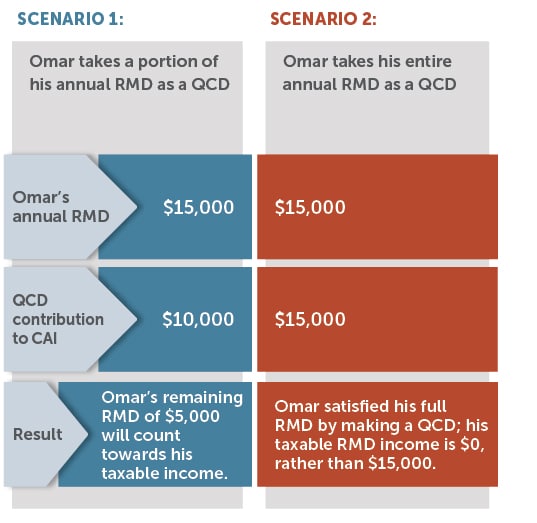
Establishing a charitable gift annuity will enable you to support CAI and feel confident that you have dependable income in your retirement years. This type of donation can provide you with regular payments for life, a portion of which may be tax-free.
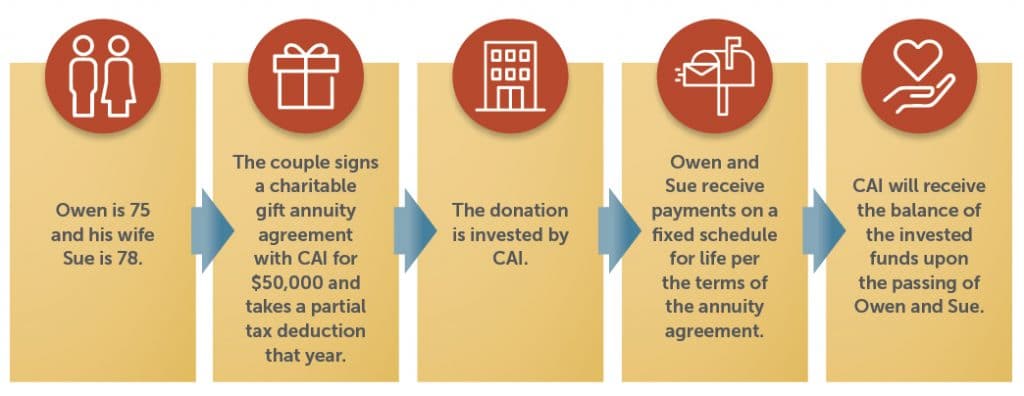
A charitable bequest is a meaningful way to plan a gift that shapes your legacy and allows you to maintain control of your assets while reducing estate taxes. The lives of thousands of people in Afghanistan, Pakistan, and Tajikistan have been changed by individuals who thoughtfully included CAI in their estate plans. A few of the ways you can leave a bequest to Central Asia Institute include naming CAI in your will or trust, or designating CAI as a full, partial, or contingent beneficiary of your retirement account, pension, or life insurance policy.
If you have already made arrangements to give a gift to Central Asia Institute by placing us in your will or trust, or through a beneficiary designation, please take a moment to let us know. By sharing your intention with us, you can work with our team to ensure your gift will be used to meet your philanthropic goals and directed to those programs that are most important to you. We would also welcome the opportunity to express to you our gratitude and provide regular and timely updates on the lives you are touching in Central Asia.
Please contact us for more information about how to support our mission in tax-wise ways. We would be honored to help!
Sonja Bahr, Senior Development Officer
sbahr@centralasiainstitute.org
406.585.7841
*All of the examples above are hypothetical and for explanatory purposes only. These illustrations are not professional tax or legal advice. Please always consult a tax advisor about your specific situation to find the best solution to meet your needs.
By Hannah Denys
Now Gulnamo is 42, and she creates elaborate, richly colored handicrafts—from traditional Pamiri socks to ornately beaded jewelry to whimsical souvenirs. Making these beautiful treasures has become her passion. She’ll find any excuse—a friend’s wedding, a family member’s birthday, or just a quiet moment—to sit and practice her art. And by doing so, Gulnamo is keeping a longstanding family tradition alive.
Women in Gulnamo’s family have been knitting and crafting for many decades, passing down the traditional knowledge and skills from mother to daughter for generations. Gulnamo’s mother, Gulkhotun, knit professionally when she was younger, working at a weaving factory in eastern Tajikistan. There she made just 50 somonis (about $5) a month. She loved the work, but said the salary “was nothing to survive on.” She wanted more for her daughter, so she encouraged her to get a college degree and pursue a career outside of crafting.
Even though Gulnamo wanted to pursue her passion for crafting, she applied to university and was accepted. With the money she earned from selling her handmade products she was able to pay her university fees. Yet, even after graduating from university, she continued spinning wool, knitting socks, and making souvenirs, often giving them to friends as gifts. Crafting would have to remain a hobby for Gulnamo, who’d given up hope that she could turn her passion into a sustainable career.
Then Gulkhotun heard about a business training workshop for women. Here was an opportunity for her daughter to both pursue her passion and make a good living.
Women like Gulnamo who live in small, mountain villages in Tajikistan almost never have an opportunity to take part in courses about starting and running a small business, despite their need for such knowledge and skills. Because of the limited jobs available in Tajikistan, people are often forced to leave the country to find work. Most go to China or Russia and send money home to their families. Reports estimate that 30% of the population of eastern Tajikistan, where Gulnamo lives, works abroad. Unfortunately, sometimes men working abroad decide to build a new life for themselves in their adoptive country, and the money they had been sending home to their families dries up. Women and children are left to fend for themselves.
For these single-parent households, it’s crucial for women to earn an income. Even for Tajik couples who stay together, a second income can help lift a family out of poverty, which is sorely needed in a country where one-third of the population lives in poverty.
During the 10-day workshop, Gulnamo and the other 118 female participants learned how to create business plans and budgets, analyze and respond to market demands, and perform basic accounting functions. They were connected to local women’s business associations, introduced to potential mentors, and shown how to apply for financing.
“This training totally changed my life,” Gulnamo says. “In the training, I learned about how to make and save money.”
“I learned how to plan my family budget, daily calculation of money and income, managing money, and saving money. The training changed my life. Within a month, I managed to hire two more ladies who work with me and are able to improve their life. Besides that, I am teaching sewing skills and sharing knowledge with the ladies to make them successful like me as a businesswoman in the village. My plan is to open my own sewing workshop and involve more housewives.”
– Fakhriya Dovutova, business program graduate
But it’s not just program participants who are benefiting from the training. Program graduates are determined to help other women and families benefit from what they’ve learned. Several of them have formed a network for female entrepreneurs that will allow members to share knowledge and pool resources. They’re even raising funds for a micro-finance program, which will help other prospective entrepreneurs pay for trainings and start companies.
Gulnamo is also planning to use what she’s learned to help other craftswomen in her community. “After saving money, I’ll start constructing a souvenir shop in my village to sell handmade crafts together with other girls,” she explains. “I’ll teach my skills of knitting, making rabbits, and other things to young girls in my village—my neighbors and nieces. Some of the young girls are already skillful in making Pamiri skull caps, socks, national dresses, and more. I want to sell all the products in the shop. A lot of tourists come through our village. They walk on the road and buy different things. This is my wish and hope for the future.”
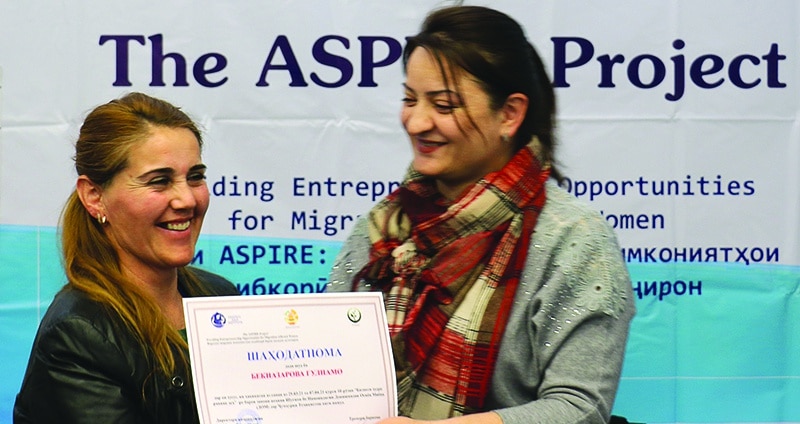
In two years, Central Asia Institute Tajikistan has trained 170 would-be female entrepreneurs. Many of them have gone on to start successful businesses. But there are many more women waiting in the wings, eager to participate in the program. They already have the vision and the passion. They just need a little bit of help to
get started.
To meet this need, Central Asia Institute Tajikistan staff hope to offer the business training course annually. In addition, they have plans to expand the program to provide financial support and ongoing mentorship to workshop graduates.
Using what they’ve learned from this workshop, women are taking their financial futures into their own hands and working to pull their families out of poverty. At the same time, they’re preserving age-old artforms and building a strong community of female business owners in one of the most remote regions of the world. As the program continues to grow and expand to reach more women, the possibilities are endless. Women can do amazing things when they turn their passions into professions.
Special thanks to the U.S. Embassy in Tajikistan for funding the 2020 pilot program.
“[Following the training], I decided to take a risk and bravely started to bake kulcha (little round loaves of bread) and took them to a small shop for selling. With the money I bought flour again, and this way increased my income. I started to save money for my children’s needs, as we learned in the training. I have a garden and orchard, but before I felt ashamed and afraid to sell the products. But the training changed my mind. I feel a great improvement in my life. I am sharing the training information with my children, who help me in making kulcha. I am planning to get a better oven to make quality kulcha, as there is big demand. Neighbors and friends order kulcha for weddings and other events.”
– Zarniso Alidodova, business program graduate
By Claudia Koechell
The Pamir and Karakoram ranges, which are part of the broader Hindu Kush Himalayan region, include some of the tallest peaks in the world and are home to a mosaic of cultures, peoples, and landscapes. Known as the “Roof of the World,” these magnificent ranges span parts of East Asia, South Asia, and Central Asia, including Afghanistan, Pakistan, and Tajikistan, the countries where Central Asia Institute focuses its work.
CAI’s programs provide support to communities in these remote, high-mountain areas, where few other international organizations work and where local culture and traditions still hold sway. Delivering on our mission of bringing education, especially for girls and women, to these areas requires meeting people where they are—understanding their values, attitudes, and traditions. We do so by working through local partners who collaborate closely with community members to ensure their buy-in and the sustainability of our programs.

For many living on the “Roof of the World”, life is lived above the clouds. The average altitude of a Hindu Kush peak is 14,700 feet above sea level, and the highest peak in the Karakoram range, K2, reaches a staggering 28,251 feet. Remote communities spread throughout isolated valleys are often cut off in the wintertime, when heavy snow and treacherous roads make transportation difficult. In addition to harsh winters, the area is prone to natural disasters like earthquakes, droughts, flooding, and mudslides. The effects of climate change are also being felt, including more frequent and severe weather-related disasters, threatening the fragile, high-mountain ecosystem on which local people depend. [See the article on climate change and girls’ education on p. 28.]
These mountain communities have adapted to the unforgiving climate over centuries. Their houses are specially designed to withstand frigid winters, keeping inhabitants warm while serving as a place of work, rest, and worship year-round. The traditional Pamiri house, a chid, is built of stones, mud-plastered walls, and flat roofing. Chids consist of a large central living room, five wooden beams that provide support and help withstand earthquakes, and an elaborate skylight built with four concentric square layers representing earth, water, air, and fire.
Households usually include the entire extended family: mother, father, grandparents, kids, aunts, uncles, and cousins. This large family structure keeps the home warm during the cold winters. It’s also common among ethnic peoples like the Balti to keep their livestock on the ground floor of the home at night to generate heat. In the summers, families do much of their work, such as spinning wool or drying animal dung for fuel, on the flat roof of their home.
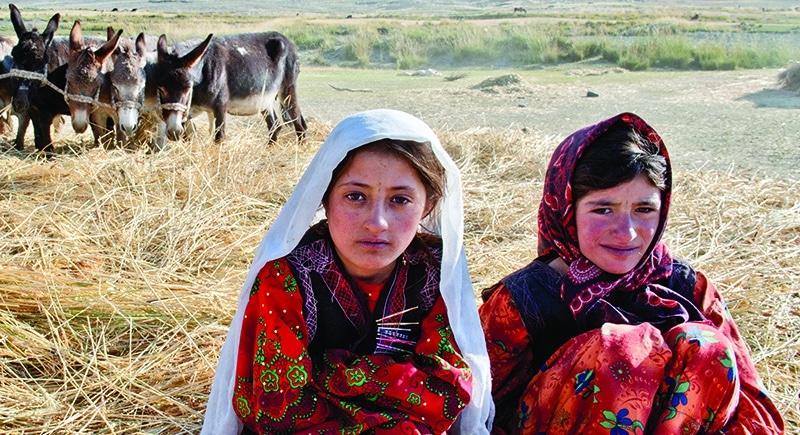
The high-mountain communities of the Hindu Kush Himalayan region are culturally rich and diverse. The people who live there have adapted to different empires and influences over the centuries yet are proud to have maintained their beliefs and traditions.
One of these populations, the Pamiri people, live in the Badakhshan region that spans Afghanistan and Tajikistan. The Pamiris are known for their hospitality and love of tradition. Classic Pamiri clothing consists of dresses and other attire bursting with bright colors, especially red, and heavy use of patterns and embroidery. These outfits are often accompanied by tokis (skullcaps), beaded jewelry, and colorful patterned wool socks.
The Baltis are an ethnic group of Tibetan descent. They live in the Karakoram mountains of northern Pakistan, in the narrow, fertile valleys formed by the tributaries of the Indus River. While not nomadic, they graze their livestock from one mountain pasture to another with the changing of the seasons. The Balti wear traditional wool clothing to keep them warm in the frigid alpine region where they live. Women usually wear black while men wear white. Both men and women wear skullcaps embroidered with flowers, berries, or leaves.
The Wakhi predominantly live in the Wakhan Corridor, the narrow strip of Afghanistan that lies snuggled between three major mountain ranges. Known to be peaceful, welcoming, and honest, the Wakhi are mostly nomadic and often have two homes, one for the winter and one for the summer. The men are responsible for farming and weaving wool, whereas the women look after the home and cattle. They love traditional music made with daf frame drums, flutes, and rababs. They also wear distinct wool headwear and use the colors
of their clothing to indicate emotion.
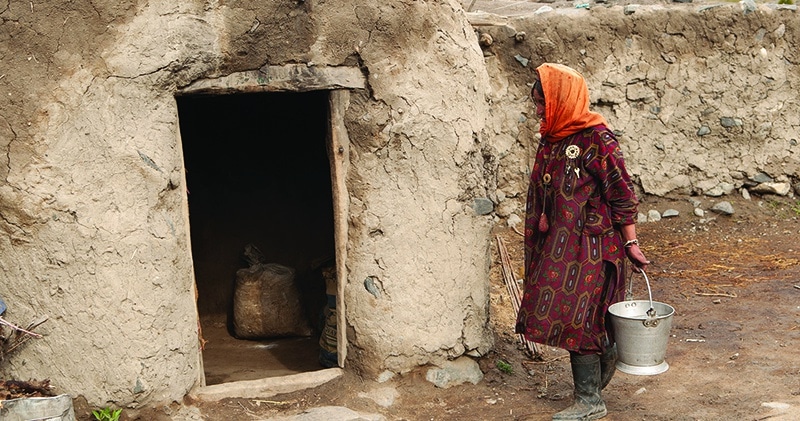
Like much of Central Asia, the mountain communities of the Pamir and Hindu Kush regions practice Islam. Many of them adhere to a lesser-known branch of Shi’a Islam, known as Ismailism. They believe that Muhammad was the last prophet of God and that the Holy Qur’an, God’s final revelation to mankind, was revealed through him. Although they believe that the Prophet Muhammad was the last of the prophets, they feel that spiritual and moral guidance is provided by his descendants. This guidance is embodied in the Aga Khan, their spiritual leader. The current Aga Khan is the 49th hereditary Imam (leader), and Ismailis believe he is a direct descendant of Muhammad. Ismailis express their values and traditions with a commitment to search for knowledge to better oneself and society, to build bridges of peace and understanding, and to share one’s time and talents.
These mountain-dwelling people live in some of the most remote and extreme conditions in the world, yet they boast a unique and beautiful mix of cultures. While each ethnic population has distinct traits, tongues, and traditions, they are unified in their place on the “Roof of the World.” Central Asia Institute is honored to work in this part of the world and serve these magnificent people.
To learn more about the rich culture and history of the people who
inhabit this unique and fascinating part of the world, please check out
the following resources:
Baltistan | Region, Kashmir, Indian Subcontinent, Asia
britannica.com/place/Baltistan
Hindu Kush
britannica.com/place/Hindu-Kush/People
In Remote Tajik Mountains, Pamiris Keep Unique Culture Alive
rferl.org/a/tajikistan-pamir-mountains/29924638.html
Karakoram Range | Himalayas, Location, and Map
britannica.com/place/Karakoram-Range
Pamiri – Introduction, Location, Language, Folklore, Religion, Major Holidays, Rites of Passage
everyculture.com/wc/Tajikistan-to-Zimbabwe/Pamiri.html
Women in Red: Afghanistan’s Forgotten Corner
cbsnews.com/pictures/wakhan-corridor-afghanistan-forgotten-corner/
SOURCES
Pamiri – Introduction, Location, Language, Folklore, Religion, Major Holidays, Rites of Passage (n.d.).
In Every Culture.
Baltistan region, Kashmir, Indian subcontinent, Asia (n.d.).
In Britannica.
Owen, L. (n.d.). Hindu Kush mountains, Asia. In Britannica.
Dmitriyevich Bessarabov, G. (n.d.). Karakoram Range mountains, Asia.
In Britannica.
The Ismaili Community (n.d.).
In The Ismaili.
By Molly Shapiro
Afghanistan’s recent fall to the Taliban has brought global attention to the immense challenges girls and women living in conservative cultures face in accessing education. While there have been enormous gains in female education in Afghanistan since the U.S.-led incursion in 2001,
millions of female students around the country may be forced to drop out of school or banned from attending should the Taliban move forward in imposing its strict interpretation of Islam.
The situation is even more fraught for girls in rural areas. Even during the 20 years of progress in girls’ education, gains were confined primarily to cities. Until the Taliban seized control in mid-August, 45% of girls in urban areas attended secondary school. In remote, rural areas that tend to lean more conservative, only 17% of girls advanced to secondary school.
For the past 20 years, Central Asia Institute’s programs have focused primarily on remote communities located miles and mountains away from more cosmopolitan urban centers. There, government schools are few and far between, and often out of reach for girls and boys alike. Even where education is available, antiquated attitudes towards the role of women and girls as confined to domestic responsibilities such as doing chores and rearing children have prevailed over centuries. Strict interpretations of Islam that require girls and boys to be separated from one another past the age of 12 also persist. These beliefs have made it much more challenging for girls living in remote, conservative areas to receive an education.
For CAI, working in these remote, conservative areas means that we and our partners have had to learn to bridge the cultural divide and implement strategies for making girls’ education possible.
One of the biggest challenges in educating girls and boys in the remote, mountainous regions of Afghanistan is that there are few formal government schools located nearby. This means that children have to travel long distances to attend classes, which creates a unique barrier for girls living in conservative cultures. Girls must be accompanied by a male relative and cannot travel alone in public. In addition, their parents understandably worry about the dangers their daughters might confront on the road. And poor families with few resources to educate all of their children often favor boys over girls when it comes to who has the privilege of going to school.
Community-based education (CBE) is designed to solve these problems. CBE involves setting up a classroom in the heart of the community, such as in the home of the teacher or another member of the community or in a local building or mosque. Girls’ parents are far more comfortable enrolling them in classes that are more private and located right in the village where students live. It is no surprise that CBE has proven to be one of the most effective strategies for educating girls in Afghanistan over the past 20 years.
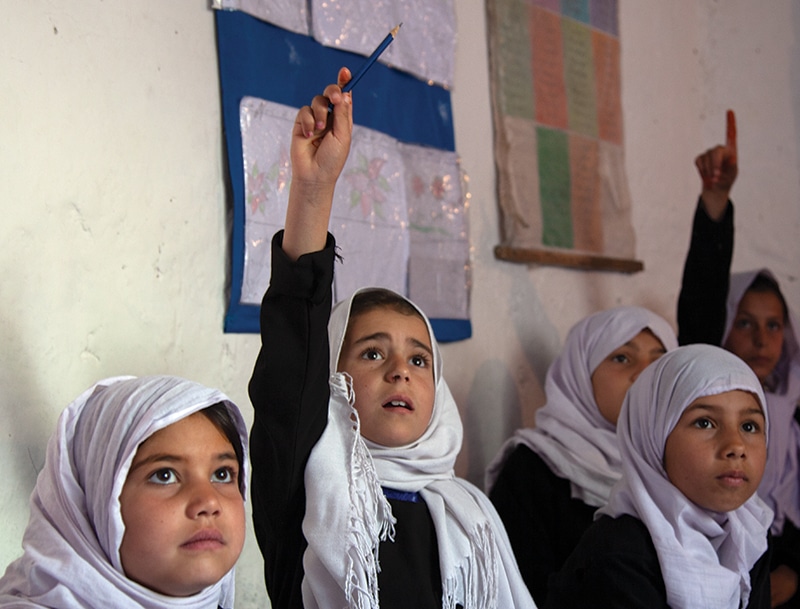
Setting up informal education opportunities to reach remote communities also requires gaining the trust and acceptance of community members. Mustafa, the deputy director of one of CAI’s partner organizations in Afghanistan, explains the intensive groundwork that must be done to engage with conservative communities that are resistant to establishing a school for girls. “We ask the community to be involved in the process and provide space in the village. We recruit teachers from the village. We establish a village council, or shura, to oversee the school. We go to the religious people to explain the importance of education for girls.”
Given the disproportionately low school enrollment rate among girls, especially in rural areas, as well as the difficulties for girls to access formal schools, CAI and its partners prioritize educational programs for girls. According to Mustafa, communities question this emphasis on girls’ education. And they often push back on the notion of hiring female teachers, saying they should not be hired over a male teacher and should instead remain in the home. “So we talk with the village elders and convince those people to let the females be involved in our project,” he explains.
Most importantly, Mustafa and his colleagues emphasize that the community has real ownership of their school. “We tell them that this program is for you and for your children,” he says. “You should monitor this program. You should monitor if our organization properly provides services to your children.”
Sometimes Mustafa and his team point to other nearby villages that have experienced the benefits of girls’ education. Or they’ll try to show that educating girls does not go against the community’s culture, customs, or religion. In the end, most villages do embrace CBE, and only in rare circumstances has the team had to give up and move on to another village.
Of course with the Taliban back in control of the government, the advances made in girls’ education are in serious jeopardy. Under the group’s strict interpretation of Islam, high school and university-level female students face far greater restrictions on their right to attend school, and possibly risk being banned from school altogether. But CAI and its partners, having worked in conservative areas over the last two decades, have learned to find a way forward that we hope will prove successful in combating new restrictions.
For example, when Mustafa learned that the head of education for the Taliban wanted to shut down a computer class for teenage girls in Nangarhar province, he went to the man’s office and convinced him to allow the class to continue. He and his team have also worked strenuously to encourage the village shuras (councils) to keep their community-based schools open—and they have. In fact, for some communities, the more the Taliban restricts girls’ education, the more they want to create these schools.
There is no telling exactly how far things will go. Yet CAI and its partners, having learned over the past two decades to bridge the cultural divide in conservative areas, remain hopeful. Besides the huge increases in the number of Afghan girls and women who have been educated over the past 20 years, one of the most notable changes in Afghanistan has been the attitude towards education. In 2019, 87% of Afghans surveyed were in favor of girls’ education, according to The Asia Foundation. This is no surprise given the value that educated females bring to their families and communities in terms of improved health, income, and quality of life. While the Taliban leadership may hope to turn back the clock, the changes in attitudes won’t be easy to reverse. This is cause for hope.
*Names have been changed out of concern for people’s safety.
Library on wheels delivers joy and knowledge to students in remote villages.
By Hannah Denys
For many children living in northern Pakistan, simply getting to school is the biggest barrier to getting an education. But with the introduction of an innovative library van last year, these children don’t need to travel to school. School can travel to them.
In 2020, Central Asia Institute commissioned a library van, something never before seen in this region. Stocked with hundreds of books, puppets, crafting materials, and more, the van’s purpose is to bring education and joy to children living in impoverished, isolated communities.
The van is an unusual sight as it bumps along winding country roads. Painted in bright colors, with the slogan “Read and go forward” emblazoned on its side, the van sparks the curiosity of bystanders.
“When we are driving on the road, all the communities and students are watching our van,” says Ismail Hunzai, who creates lesson plans for children and sometimes travels with the van. “And they are asking questions: ‘What is this and what are you doing here?’”
The library van is uniquely able to reach remote villages with high numbers of out-of-school youngsters. In these areas, children often want to be educated, but their families can’t afford it or there isn’t a school nearby. Low school enrollment and attendance rates are big problems for many of the towns in northern Pakistan and throughout the country.
“[Older children] might be allowed to go to school using public transportation or by walking,” explains Ms. Hira Amir, the instructor who travels with the van. “Because of this, some children only go to school three days a week [if they go at all]. But little children—girls and boys—many of them are not able to go to school because the school is too far away from their village.”
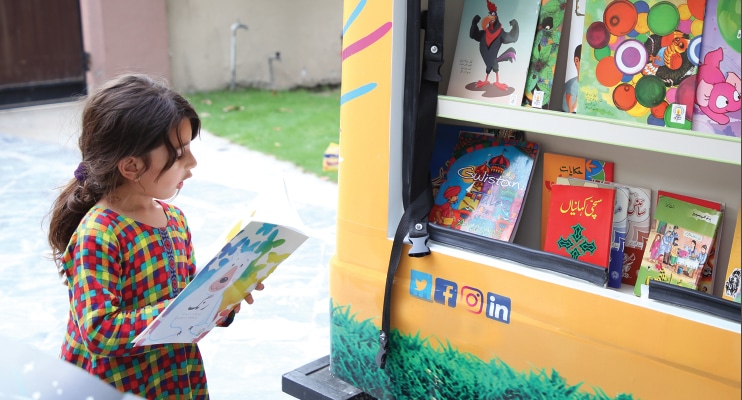
Thanks to the library van and the free classes it offers, these young children now have a chance to learn. Hira teaches them about reading, writing, math, art, critical thinking, and more. There’s even a lesson on gardening. All the exercises are interactive and encourage students to ask questions. Many are designed to bridge the gap between classroom learning and daily life.
Hira feels the lessons on nature and climate change are especially good at accomplishing this. One of her favorite books from the library talks about the importance of conservation. “Trees are our friends,” she says. “In the village, we see trees all around us. That’s why I teach [the students] to take care of trees. Trees are good for our health.”
Conservation is crucial in northern Pakistan, where farmers are clearing more and more trees to make room for farmland. There is a growing concern about deforestation and climate change throughout the country, yet the solutions and need for wild spaces are not widely talked about. (See page 28 for more information on climate change and girls’ education.)
Mr. Babar Khan, the library van project manager, speaks passionately about the need for more lessons that have real-world impacts. “Our classrooms are disconnected from our society,” he says. “Where and how will the classroom content be applied in your practical life? [This story] from the library is an example of how we can connect classroom learning and sensitize children and make [conservation] part of the social norm—to be a part of nature and not the enemy of nature. We are trying to introduce this concept to children at an early age so that it will last.”
Hira visits up to three villages a day. Throughout the month, she’ll service approximately 15 different locations, spending one to two hours in each village. Hira wishes that she could stay longer in each place, but due to the steep mountain terrain, the remote locations of the villages, and the poor quality of the roads, her drive to the next village is often long and slow.
Even though their time with the van is limited, children and adults have come to look forward with excitement to its arrival and all the treasures and joy it brings. “I am always welcomed by smiling faces,” says Hira. “And when I ask them if I can go, they always say ‘No, madam! We want more activities!’”
It’s no wonder that the communities love the library van. Few villagers have books to open their minds and imaginations to new information and ideas. And having engaging learning activities is a new concept for students in Pakistan. Teachers rarely use interactive materials like the ones Hira employs. Teaching methods have historically focused on rote memorization and preparation for end-of-semester tests. Without interactive, playful lessons, students who go to government-run or private schools are slow to grasp or retain most of what they are taught and unable to analyze information.
To get a sense of what they were up against, Ismail conducted a survey when the van program was getting started. Children were tested on their knowledge of basic concepts, like the alphabet and numbers. Most scored very low on the assessment. Ismail used what he learned to design specific activities for each village. Activities that Hira uses with students are selected based on the assessment results.
The progress they’ve witnessed has been incredible. When the children were first tested, almost none of them passed the assessment. After one year, students were retested using the same assessment. This time, approximately 80% of students passed the test. Of the 20% who didn’t, most had poor attendance or had joined the program late. The library van team is targeting these students for
special attention so they can catch up with their peers and be able to read, write, and speak English and Urdu—the two national languages—at a passable level in the next few months.
The success of the van has been so impressive that other educational organizations have taken note, and several are considering replicating the program in other parts of the country. The van could be an innovative way to provide some of Pakistan’s 22.8 million out-of-school children with a different pathway
to learning.
To increase the reach of the program, Central Asia Institute recently equipped a second library van, which will visit villages in the northeast, while the original van will continue to travel in the northwest. But even with the second van, there are still many children who remain without access to education.
Eighteen communities have contacted the library team about having the van visit their villages. In addition, people along the van’s routes will often ask the driver to make a stop at their village. But with limited time and resources, the library team cannot add additional villages to their routes at this time.
“Yesterday, we were in one village called Basseen, near Warzah, a poor area where people live in tents and don’t know about education,” explains Amir, the library van’s driver. “All the children were on the side of the road swimming in the river. I asked them ‘Why are you not going to school?’ They told me that school is very far so they cannot go to school. The girls are at home doing chores and washing clothes, so they are not able to go to school either. These children don’t even know what a pencil is. So I showed them a pencil and how to use it. They were so interested.”
When he returned to the district office at the end of the day, Amir shared this story with his boss. He hopes that one day he’ll be able to give these children the education they deserve and crave.
Until that day comes, he and the rest of the library van team are so grateful for being able to change so many lives with this project.
“Thanks deeply from the core of our hearts to the donors of CAI,” said Babar. “You provided us the opportunity to make a difference in the lives of these children. There are still children out there waiting for us to create these opportunities for them, but whatever progress we have made so far is thanks to you, the donors. We wish to convey our deepest thanks to you. We appreciate your support and trust.
By Alice Thomas
Afghan women and girls face an uncertain and ominous future.
Now that U.S. and NATO forces have withdrawn and the Taliban has regained power, women and girls fear a return to the brutal repression of freedoms and rights they experienced two decades ago. Unfortunately, it is becoming more and more apparent that these fears could become reality.
Despite promises to the contrary, the Taliban’s new cabinet does not include a single woman. The Ministry of Women’s Affairs has been disbanded and supplanted with a Ministry of Virtue and Vice, known under the prior regime for brutally enforcing the group’s strict interpretation of Islam under Sharia law. In addition, within weeks of the Taliban’s coming to power, the rights of Afghan women and girls to education and work were already being significantly curtailed—not to mention the broader rights of all Afghans to freedom of religion and movement. All around the country, there are reports that women who previously worked in government offices, banks, and other businesses are being told to go home “where they belong.”
While primary schools have continued to operate for girls and boys, in late September, the education ministry ordered male students and teachers back to high school, but made no mention of female students, raising fears that girls would be banned from attending school beyond the sixth grade. Following public outrage, the Taliban quickly backed down, announcing girls would be permitted to return to secondary school “soon.” But what that will look like and under what conditions remains uncertain.i
In some regions of the country, female students have been prohibited from attending university, including Kabul University, the country’s premier public university. In late September, the school’s new, Taliban-appointed chancellor proclaimed that female students and teachers would be banned altogether from attending.ii More broadly, the Taliban’s new education minister recently declared that going forward, women and men must be educated and work separately. This would effectively act to limit girls’ ability to attend anything beyond primary school given the limited number of high school and university teachers who are female. Women who have been permitted to attend certain universities are also being forced to wear long, black abayas that cover their entire bodies and a niqab over their faces, leaving just their eyes uncovered.
For Afghan women and girls, the extent of sorrow and loss they are feeling cannot be overstated.
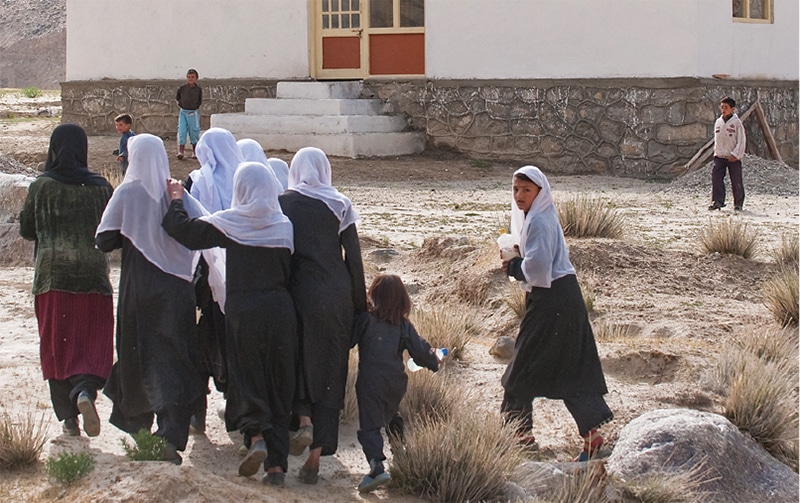
But there may be reason for hope. Today’s Afghanistan is different in important ways from when the Taliban last held power. There has been significant progress in Afghan women’s and girls’ access to education, jobs, and political participation. Most notably, literacy rates among girls have doubled. Of the 9 million students enrolled in school in 2018, 3.8 million were female. When compared to 2001, when virtually no girls were enrolled in school, this represents enormous progress.iii
In urban areas, before the recent takeover by the Taliban, 45% of girls attended secondary school. (Although in rural areas, progress has been much slower with only 17% of girls advancing to secondary school.) Over the past 20 years, the number of schools increased 10 times and the number of female primary teachers grew to approximately one-third of the nation’s teachers.iv Public support for education has also dramatically increased. A 2019 survey across all 34 of the country’s provinces found that 87% of women and 85% of men supported women’s access to education.v
In the past two decades, women have also seen important gains in terms of access to jobs. As of 2017, approximately 40% of working-age adults were female. There are more women-run businesses than there were 20 years ago, and there have been meaningful improvements in women’s participation in the Afghan Parliament, police, and judiciary. While surely not enough, these are nonetheless important milestones of progress.vi
With the situation still evolving, it is this generation of educated women who are emerging as seeds of hope. As of late September, women across Afghanistan were publicly protesting Taliban edicts that would ban them from holding government office and entering the workforce. They are risking their lives, knowing that such protests have already been brutally repressed. But they have not been deterred, and the world has been astounded by their bravery.
Afghan women inside and outside of the country recently launched an online media campaign protesting the new restrictions on dress. Using hashtags like #DoNotTouchMyClothes and #AfghanistanCulture, women are posting pictures of themselves on social media wearing traditional Afghan women’s clothing characterized by bright colors and embellished with embroidery and small sparkling mirrors. In doing so, these women are not only rejecting niqabs and burkas but reclaiming their identities as well. As one Afghan women’s rights advocate explained, “Our traditional clothes represent our rich culture and history of 5,000 years, which makes every Afghan feel proud of who they are.”vii
Propelling these brave women is the thought of a life without the rights to work, education, or self-determination; a life confined to their homes; and a life stripped of books, music, laughter, and hope. For them, this is no life at all.
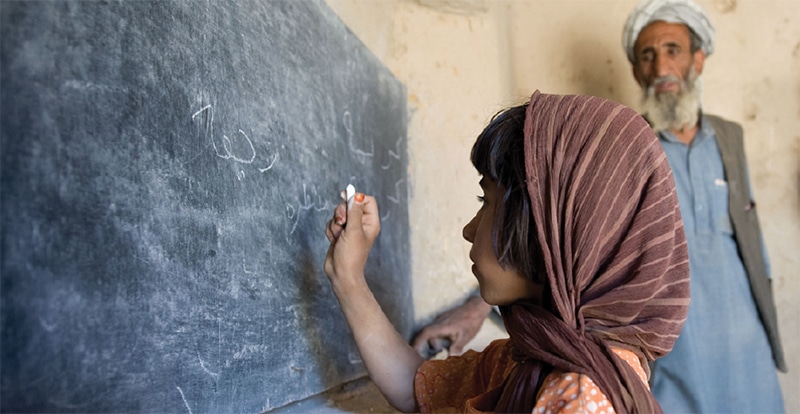
What girls’ education will look like under Taliban rule is far from clear. In Central Asia Institute’s experience, even in those areas that have long been under Taliban control, practices can vary when it comes to what is acceptable. Whether this will continue to be the case now that the Taliban rules the entire country is hard to say. But among the Taliban, significant differences of opinion with respect to education suggest that going forward, a uniform approach to girls’ education may be hard to achieve. Recently, there have been disagreements between hardliners and those who recognize that Afghanistan needs a better and more modern educational system.viii
It is true that for now, Afghanistan’s women and girls face a dark future. Yet there is an entirely new generation of Afghan women and girls who have emerged over the past two decades. They are both proof and hope of what remains possible. Education will empower Afghan women and men all over the world to fight for a better future for themselves, their families, and their country.
i. Zucchino, D., & Blue, V. (2021, September). A Harsh New Reality for Afghan Women and Girls in Taliban-Run Schools. In The New York Times. https://www.nytimes.com/2021/09/20/world/asia/afghan-girls-schools-taliban.html
ii. Engelbrecht, C., & Hassan, S. (2021, September). New Taliban Chancellor Bars Women from Kabul University. In The New York Times. https://www.nytimes.com/2021/09/27/world/asia/taliban-women-kabul-university.html
iii. The Right to Education: What’s at Stake in Afghanistan, 20 Year Review (2021, September). In UNESCO. https://en.unesco.org/news/unesco-sounds-warning-what-stake-education-afghanistan
iv. Afghanistan: Women’s Economic, Political, Social Status Driven by Cultural Norms (2021, April). In National Intelligence Council. https://www.dni.gov/files/ODNI/documents/assessments/SOCM-AFG_Women.pdf
v. A Survey of the Afghan People: Afghanistan in 2019: Infographics (2019, December). In The Asia Foundation.
vi. Supra note iv
vii. Afghan women hit back at Taliban with #DoNotTouchMyClothes campaign (2021, September). In BBC. https://www.bbc.com/news/world-asia-58550335
viii. Supra note iv
*The situation in Afghanistan is changing rapidly. For the most up-to-date information about what’s happening on the ground and our efforts to support the Afghan people, please visit centralasiainstitute.org
 My name is Aisha, and I was born in Afghanistan. You will read part of my story in this magazine. My story has the potential to be a happy one. But right now, I’m not sure how happy the ending will be.
My name is Aisha, and I was born in Afghanistan. You will read part of my story in this magazine. My story has the potential to be a happy one. But right now, I’m not sure how happy the ending will be.
In the summer of 2021, I was forced to flee my home because I feared for my life. The Taliban were moving closer and closer to my village. My family and I fled to Kabul, where we hoped we would be safe. Now I live on the streets and am waiting to know my fate.
Tragically, my story is not unique. There are hundreds of thousands of people just like me. We are young people who had big dreams—dreams that we now fear won’t come true because of the Taliban, because of people who think they can decide our futures, ignorant people who don’t want us to be connected to the world, who don’t want us to explore or to read or to learn, and who don’t want women to have even the most basic human rights.
But I have hope. I am hopeful because I know that our sisters and brothers around the globe haven’t forgotten us. As you read the stories in this magazine, know that there are real people behind these words. We have real hopes and real fears.
My sisters and brothers, we know the future is uncertain. But when you keep us in your hearts, you give us hope for a happy end to our stories. Please do not let the darkness of ignorance win!
Sincerely,
Aisha
*The author’s name has been changed to protect her identity.